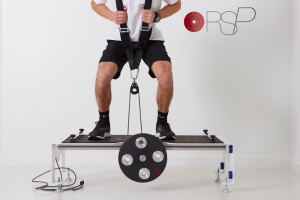RSP SQUAT
IT IS OUR FIXED RADIO MACHINE DESIGNED TO TRAIN THE BRAKING AND PUSHING ACTIONS OF THE LOWER TRAIN
ABOUT RSP SQUAT
Our fixed-radius machine for training the braking and pushing actions of the lower body based on the movement of the Squat and its vertical traction variants.
Fixed radius machines have the particularity that the axis is the same during the whole stroke, so all the variations in the acceleration of the machine depend on the capacity of the sportsman to apply force in that movement.
They have a more structural orientation at a muscular level as they are slower than a conic pulley machine and allow for more time of tension as they have a lower acceleration and therefore slower movements. To emphazise this fundamental characteristic in the fixed radius machines is by using the 1×2 transmission that requires the athlete to apply more force and to increase the time of tension during the entire path of the movement.
It is important to point out that the movement that we are going to make on the machine, the squat or some of its variants has a very big peculiarity: meaning that in this exercise our body will be submitted to the action of the gravity so that in the concentric phase of acceleration we will have to counteract its negative action acting against our application of force, slowing us down.
While in the eccentric phase of braking, this action of gravity on our body will be added to the force generated by the speed of rotation of the flywheel inertia making the braking phase (eccentric) more intense and demanding than the concentric and technically more complex for the athlete by having to manage a significant overload in the same space.
HOW TO ADJUST THE RSP SQUAT?
Fixed radio machines have only one way to vary the load of the machine and therefore the response of the machine is the same as to the force applied by the athlete:
-Varying the Moment of inertia: the moment of inertia is defined as the minimum value of force that the athlete has to apply to vary the machine´s state of rest, this means that the higher this value is, the more force the athlete has to apply to start and stop the machine, and the more time he will need to stop the machine and start it again (slower the Eccentric/Concentric transition)
This will mean that as we increase the value of inertia, we will increase the time of tension and the value of force that the athlete can apply making the movement slower.
To find out more about this, see our article
HOW TO USE THE RSP SQUAT
With this machine you will be able to perform all the movements related with the Squat and its variants for these gestures to be as efficient as possible. It is very important to adjust the path of the rope with the movement we want to train, so that the end of the concentric phase (farthest point) coincides with the limit of the rope to keep it always tense and avoid losing tension. To adjust it, we must stand up at the maximum extension position in which we want to finish our movement and adjust the rope to this length.
In this machine, since we work with a harness that pulls us down and the dynamic of the movement forces us to make the concentric and eccentric phase a continuum,a period of familiarization is required to complete this out correctly.
To facilitate this adaptation we may give the athlete a few extra centimeters (5-8cm) of rope path to give him more time to make the transition upwards avoiding the machine´s traction with extended legs which is abrupt and the whole objective of work of the machine is lost by blocking all the energy generated in the concentric phase preventing the athlete from having to stop it.
TECHNICAL SPECIFICATIONS
| Size: | 114 x 54 x 37 cm high. |
| Weight: | 37 kg. |
| Accessories: | – Stainless steel masses – RSP Encoder |
| Spare parts: | – Pulley for a 1×2 transmission – Rope (4 meters) |
| See spare parts and accessories: |
Moments of inertia
| Without masses: | 374,68 Kg/cm² |
| 2 masses: | 449,616 kg/cm² |
| 4 masses: | 524,55 Kg/cm² |
| 2 masses Stainless +60% | 605,88 Kg/cm2 |
| 4 masses Stainless+120% | 833,09 kg/cm2 |
| 2 masses stainless/2 alum +80 % | 681,62 Kg/cm2 |
STANDARD EQUIPMENT
– RSP Squat chassis
– 4 aluminum masses to vary the moment of inertia
– 2 Adjustable side footrest
– 1 Harken Carbo pulleys 57 mm diameter for 1×2 gear ratio
– 4 meters of high performance rope with quick length adjuster
– Adjustable harness
– Assembly manual



